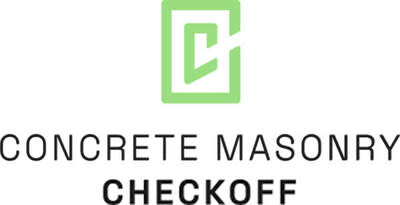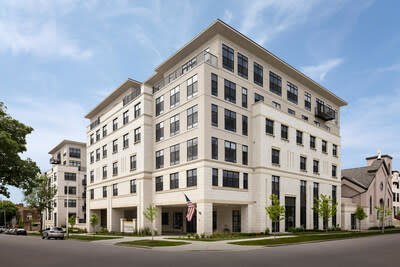From Contemporary Designs to Carbon Sink and Cost Savings: There's More to Concrete Block Than Meets the Eye
Newfound Concrete Masonry Checkoff shines spotlight on the unexpected benefits of building with block
DENVER, April 17, 2024 /PRNewswire/ -- As climate extremes and environmental accountability coalesce, the need for more resilient structures has never been more apparent. Concrete masonry construction is uniquely positioned to help communities overcome these challenges, and more.
Concrete masonry is well known for its structural capability, safety and resiliency. However, other inherent benefits like aesthetics and design flexibility, energy efficiency and low embodied carbon are underutilized or unknown altogether.
After more than a decade in the making, the U.S. Department of Commerce authorized the establishment of the Concrete Masonry Checkoff (CMC). CMC is entirely funded and led by industry, with a mandatory penny-per-block-sold assessment to support research, education, and promotion around the value of concrete masonry construction. Similar efforts in other commodities-based industries, from the U.S. Highbush Blueberry Council to The National Honey Board, have seen product demand soar from sustained investment and communication.
With CMC now in place, architectural, engineering and construction professionals will be the focus of communications that encourage them to rethink what's possible with block.
"There's not a project that couldn't benefit from the all-around appeal of concrete masonry," said Kim Spahn, CMC CEO. "Strength and durability are a given, but the economic and environmental advantages of block extend far beyond stairwells and elevator shafts." When it comes to curb appeal, Spahn says concrete masonry is limited only by imagination. "Its modular nature combined with a variety of textures, tones and finishes allow you to achieve a stunning appearance inside or out that won't lose its luster."
Versatility and Design
Comprising clean lines and geometric shapes, concrete masonry allows for the creation of intricate patterns and contemporary designs. Over time, concrete masonry maintains its intended aesthetic without warping, rotting, rusting or combusting.
"With concrete masonry, you don't have to sacrifice aesthetics for resilience," Spahn added. "Whether your focus is commercial or residential, block gives you the best of both worlds."
Whatever the style, concrete masonry easily integrates with other materials such as glass, steel, or wood, creating visually interesting contrasts and combinations.
Carbon Conscious
Sustainability claims don't always account for the considerable transportation impacts associated with sourcing building materials from afar. Concrete masonry units (CMUs) are produced locally in all 50 states which helps builders comply with green building requirements mandating that materials be sourced near their jobsite.
CMUs start to sequester carbon from the atmosphere as soon as they're formed and continue to absorb CO2 over the duration of their life through a process called carbonation. Block contains calcium hydroxide which reacts with carbon dioxide to form calcium carbonate, a solid mineral that effectively locks in carbon. This naturally occurring process can help to offset new-build carbon emissions.
"For new construction to be deemed 'sustainable', embodied carbon has become the new standard," said CMC Board Member and Chair of the Programs Committee, Heidi Jandris. "With the latest studies we're starting to see just how big a role concrete masonry stands to play in reducing a project's carbon footprint. CMU is made with dry-cast or zero slump concrete which sequesters more carbon dioxide at a much faster rate than other types of concrete."
On the manufacturing side, block producers across the country are adopting new processes to reduce embodied carbon. Strategies include substituting new and novel materials for traditional cement, optimizing mix designs, and emerging solutions for utilizing CO2 in the manufacturing process.
Longevity and Savings
Given block's ability to withstand extreme conditions, it's typical to expect an operational life long into the future. "Many parts of the world have relied on concrete for centuries—it's rooted in their culture and rich history," said Major Ogilvie, Chair of the CMC Board. "Here in the U.S., it's perplexing to see when structures are built, and rebuilt, with materials that simply aren't designed to last."
Many disaster-prone regions across the country have adopted a proactive approach to loss prevention by legislating the use of concrete block. According to Florida's Block Strong program, 99 percent of homes in South Florida now feature concrete construction, namely block. After Hurricane Andrew in 1992, residents, code officials, engineers and designers worked to enhance local building requirements to position concrete block as the preferred, practical solution against the looming threat of damaging winds.
Occupants of both residential and commercial concrete masonry structures in any region enjoy savings derived from lower energy bills, as the inherent thermal mass keeps spaces warmer in winter and cooler in summer. This allows for the installation of smaller, more efficient and affordable HVAC systems.
Insurance premiums to cover concrete structures also tend to be lower because providers project damage claims to be few and far between, and costs to repair after extreme events are lower than having to rebuild.
A May 2021 study from the Southeast Concrete Masonry Association (SCMA) compared construction costs in Charlotte, N.C., finding that concrete masonry units were 5 to 6 percent cheaper than conventional wood and light gauge steel framing. SCMA's insurance cost studies in Charlotte and Atlanta found that Builders Risk Insurance went down more than 50 percent with concrete masonry, with Actual Property Insurance being 2.5 to 3 times cheaper for CMUs compared to wood-framing.
To learn more about the unexpected benefits of concrete masonry, visit www.concretemasonrycheckoff.org/newsroom.
ABOUT THE CONCRETE MASONRY CHECKOFF
The Concrete Masonry Checkoff (CMC) is an industry funded initiative to support education, research and promotion of manufactured concrete masonry units in the United States. The Concrete Checkoff Program is the first-ever Checkoff Program at the Department of Commerce. For more information, visit https://www.concretemasonrycheckoff.org/.
Media Contact:
Tom DiBacco
(202) 420-0593
tdibacco@clutchperformance.com


View original content to download multimedia:https://www.prnewswire.com/news-releases/from-contemporary-designs-to-carbon-sink-and-cost-savings-theres-more-to-concrete-block-than-meets-the-eye-302118550.html
SOURCE Concrete Masonry Checkoff


